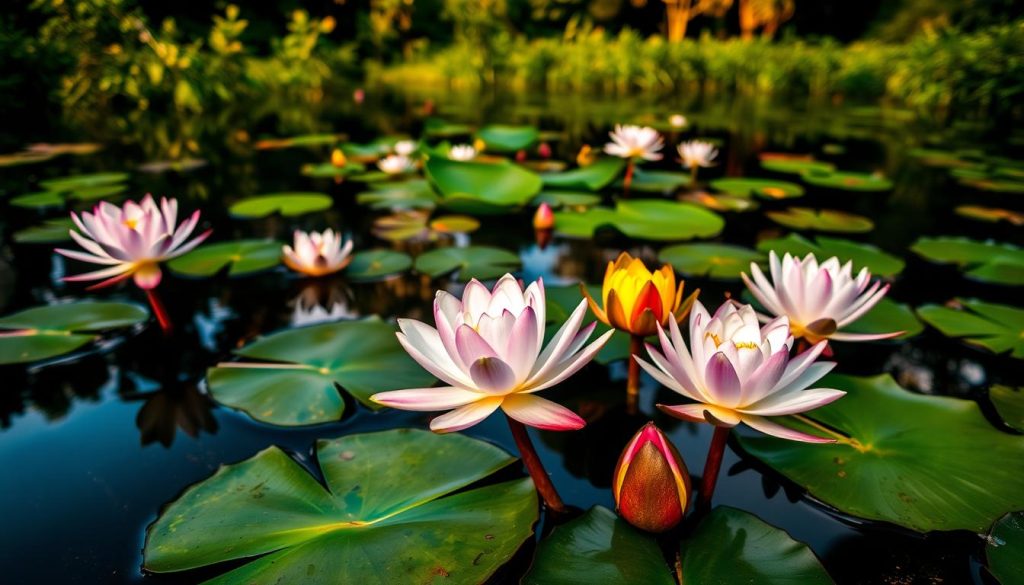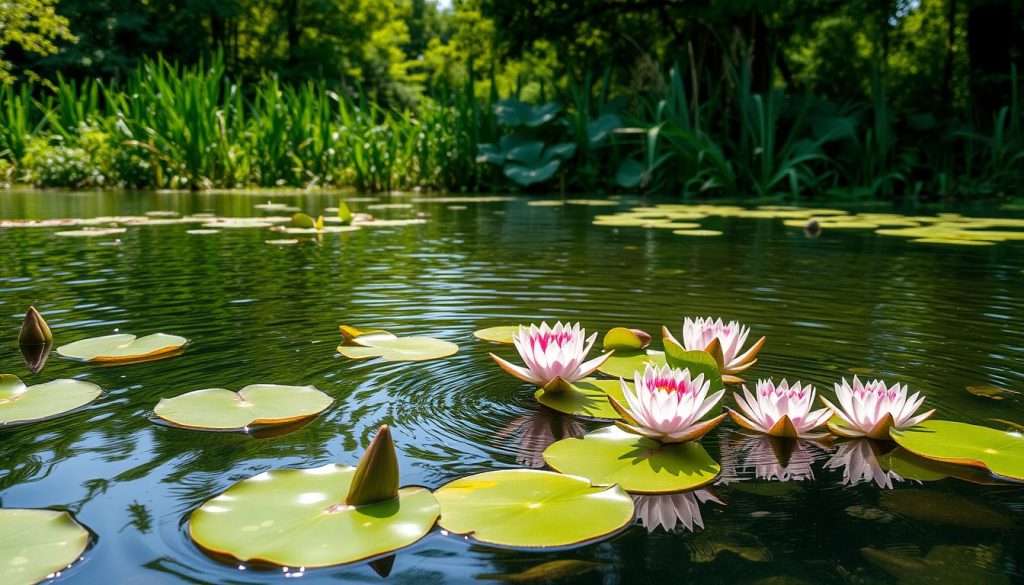Waterlilies: Captivating Aquatic Plants for Your Garden Oasis
Waterlilies bring elegance to ponds and water features with their bright blooms and green leaves. They love full sun and turn backyards into peaceful spots. They grow well in Florida and cooler places, like USDA zones 3-11.
These plants are beautiful all year, with some blooming from spring to fall. They come in different sizes, from 3-6 feet wide, and flowers are 4-9 inches big. They fit well in small containers or big ponds, making them great for any garden.
Key Takeaways
- Adaptable across USDA zones 3-11, thriving in diverse climates.
- Flower sizes range from 4-9 inches, creating dynamic visual impact.
- Perennial plants that return yearly, reducing replanting needs.
- Non-toxic to pets, ensuring safe family-friendly garden design.
- Low maintenance with proper sunlight and water depth (12-24 inches).
Introduction to Waterlilies
Waterlilies are aquatic plants that add beauty to water gardens. They belong to the Nymphaeaceae family, with 60 species. These plants have large leaves and colorful blooms, making ponds look stunning.
What Are Waterlilies?
Nymphaeaceae species grow underwater, with leaves floating on the surface. Their flowers bloom above the water, in colors from white to red. These plants are crucial for ponds, providing oxygen and homes for aquatic life.
Types of Waterlilies
- Hardy waterlilies: Can handle cold, like the pink Nymphaea ‘Pink Grapefruit’.
- Tropical waterlilies: Need warm weather, such as the blue Nymphaea ‘Blue Capensis’.
- Night-blooming varieties: Open at dusk, like Nymphaea ‘Red Cup’, attracting moths.
The History of Waterlilies
Waterlilies have inspired art and culture for centuries. Ancient Egyptians saw them as symbols of rebirth. French painter Claude Monet painted his garden’s waterlilies over 200 times.
Today, their beauty continues to inspire gardens and scientific studies.
Benefits of Adding Waterlilies to Your Garden
Turn your outdoor area into a thriving ecosystem with waterlilies. These plants do more than look good—they help balance nature and function. They attract wildlife and clear the water, adding value beyond looks.
Aesthetic Appeal
Waterlilies make ponds into living art. Their floating leaves and vibrant flowers, like the fragrant Nymphaea odorata, bring beauty. With over 50 species, they fit many tastes and climates.
Wildlife Habitat
These plants offer homes for frogs and dragonflies. Birds like herons find places to perch, and fish hide under leaves. They help create a balanced pond ecosystem.
Water Quality Improvement
Waterlilies clean the water naturally. Their roots take in nutrients, stopping algae and keeping water clear. They also block sunlight, cooling the water for fish and other aquatic life.
Choosing the Right Waterlily for Your Pond
Choosing the perfect water lilies begins with knowing your pond. First, think about sunlight, pond size, and climate. For example, hardy water lilies do well in cold places. On the other hand, Nymphaea ‘Blue Capensis’ prefers warmer weather.
Also, consider when they bloom and their colors. This will help match your garden’s look.

Factors to Consider
- Pond Size: Small ponds are great for Nymphaea pygmaea ‘Alba’ (up to 45cm spread), while large ponds can handle Nymphaea alba (2m spread).
- Climate: In warm places like Florida, tropical ‘Red Flare’ blooms until frost. In the north, ‘Sirius’ (9-inch blooms) is a good choice.
- Light Requirements: Your plants need 4–6 hours of sunlight daily. Night-bloomers like ‘Blue Beauty’ add beauty at night.
Popular U.S. Varieties
- Pond Size: Small ponds are great for Nymphaea pygmaea ‘Alba’ (up to 45cm spread), while large ponds can handle Nymphaea alba (2m spread).
- Climate: In warm places like Florida, tropical ‘Red Flare’ blooms until frost. In the north, ‘Sirius’ (9-inch blooms) is a good choice.
- Light Requirements: Your plants need 4–6 hours of sunlight daily. Night-bloomers like ‘Blue Beauty’ add beauty at night.
Popular U.S. Varieties
Tricker’s has grown water lilies for over a century. Favorites include ‘Attraction’ (vibrant red) and ‘Chromatella’ (yellow). Tropicals like ‘Director George T. Moore’ (navy blue) and ‘Pink Grapefruit’ (pink blooms) are also popular. For small ponds, ‘Pygmaea Helvola’ (pale yellow) is a great choice.
Purchase Options
Buy water lilies from trusted places like Tricker’s or online. Look for healthy plants with strong roots and no yellow leaves. Also, check local garden centers for plants that fit your area’s climate.
Planting Waterlilies: A Step-by-Step Guide
Turn your pond into a colorful aquatic garden with these easy steps. Whether you’re starting small or have a big pond, these tips will help your waterlilies grow well. They’ll bloom beautifully from the start.
Best Time to Plant
Start planting hardy waterlilies in early spring after the frost goes away. Wait until the water is at least 70°F to plant tropical ones. In zones 3–11, plant hardy types in April. Tropical ones do best in zones 9–11, planted in May or later.
Soil and Container Recommendations
- Use heavy garden loam without peat moss to anchor roots
- Choose wide, shallow containers (12–20″ diameter, 8–10″ deep) for proper rhizome growth
- Example: Nymphaea pygmaea ‘Alba’ fits in 12″ pots, while Nymphaea ‘James Brydon’ needs 18–20″
Planting Procedure
- Fill container with soil, leaving 2–3″ space at top
- Position tuber at a 45° angle with the growing tip facing the container’s center
- Cover with 1″ of gravel to hold soil, then add a slow-release fertilizer tablet
- Submerge container to depth: 12–18″ for small types, 18–30″ for medium, up to 4′ for large varieties
- Gradually lower container into water, ensuring leaves float at the surface
Within 10 days, new leaves should appear. Tropical species might need extra warmth at first. For the best growth, fertilize monthly and prune spent blooms weekly to encourage more flowers.
Optimal Conditions for Waterlily Growth
To grow water lilies well, you need to know about light, depth, and climate. These plants do best in a balanced environment.

Sunlight Requirements
Water lilies need 6–8 hours of direct sunlight each day. Full sun makes them bloom more, but some types do fine in partial shade (4–6 hours). Choose a spot based on your pond’s light.
Shadier areas might cut down on blooms but still help them grow.
Water Depth Considerations
- Hardy varieties grow best 12–18 inches below the water surface.
- Tropical types prefer 18–24 inches of water depth.
- Plant dwarf water lilies no deeper than 5 inches for healthy growth.
- Position rhizomes at a 45° angle in containers with 2–3 inches of headspace.
Temperature and Climate Preferences
Hardy water lilies can make it through Utah winters if the pond is deep enough. Tropical varieties need warm water and air, making them annuals in USDA zones 1–9. In Missouri, tropical lilies are taken inside for the winter.
The Missouri Botanical Garden has successfully grown Victoria water lilies. They need water over 72°F to thrive.
Maintenance Tips for Healthy Waterlilies
Keeping your waterlilies healthy is easy with regular care. Whether you’re new to gardening or have experience, a few steps can help. Let’s look at how to keep your pond looking great all year.
Regular Care Practices
To keep your waterlilies in great shape, follow these steps. Prune dead leaves and spent blooms every week. This helps new growth. Use sharp shears to cut stems just below the water.
Fertilize every 4–6 weeks with slow-release tablets made for aquatic plants. Keep an eye on the water pH (6.5–7.5) to avoid stress. Divide overcrowded plants every 2–3 years to prevent root competition.
Pest and Disease Management
Look out for pests like aphids or beetles, which can harm leaves. Use a damp cloth or organic insecticidal soap to remove them. Yellow leaves might mean your plants need more nutrients.
For diseases like leaf spot, remove affected leaves and apply fungicides. Check your plants weekly to catch problems early.
Seasonal Maintenance Tasks
- In spring: Trim old roots and repot if needed before growth resumes.
- In summer: Increase fertilizer use for peak blooms and check for algae buildup.
- In fall: Reduce fertilizer as growth slows and prune aggressively to prepare for dormancy.
- In winter: Move tropical varieties indoors in zones colder than USDA 9–11. Place hardy species in deeper water (18–30 inches) to protect roots from freezing.
Follow these tips to keep your aquatic plants the highlight of your garden. A little care goes a long way in maintaining a balanced and beautiful pond ecosystem.
Propagating Waterlilies: How to Multiply Your Plants
Grow your aquatic garden by multiplying water lilies. Hardy types like the Mottled Trio Leaf Collection’s Leopardess, Janice, and Pink Perfection are easy to divide. Follow these tips to create more plants and keep your pond lively.
Division Techniques
Divide mature plants every 2–3 years when they bloom less or have crowded roots. Here’s how:
- Timing: Divide hardy varieties in early spring. Tropical types can be split anytime except winter.
- Split the rhizome: Use clean shears to cut rhizomes into 4–6-inch sections. Each division must have a growth node (a small bump on the rhizome).
- Replant: Place divisions in 14-inch-wide pots filled with heavy clay soil. Submerge 4–6 inches deep for the first few weeks.
Tropical water lilies grow plantlets on leaves. Simply clip these and root them in warm water. Seed propagation is also possible but takes longer.
Successful Propagation Conditions
New divisions need care to thrive:
- Water depth: Keep divisions 4–6 inches underwater initially. Gradually deepen to standard levels as they grow.
- Fertilize monthly: Use tablets made for aquatic plants during the growing season (June–October).
- Watch for growth: Look for new leaves in 4–6 weeks. Adjust depth or nutrients if needed.
By following these steps, you’ll soon have thriving water lilies. The Mottled Trio varieties, with their bold colors like Leopardess’ blue blooms and Janice’s white flowers, are perfect candidates for division. With patience and care, propagation turns one plant into a lush aquatic display—all while keeping your garden fresh and full.
Designing Your Garden Oasis with Waterlilies
Turn your backyard into a peaceful haven by placing waterlilies at its heart. Choose varieties with different bloom colors and leaf textures. This will make your water garden visually interesting.
Put larger waterlilies near the pond’s edge for a clear view. Scatter smaller ones to add depth. This mix creates a beautiful scene.
Pairing with Other Aquatic Flowers
Add vertical plants like papyrus or irises for height. Floaters like water hyacinth cover the surface. Marginal plants like pickerelweed form natural borders.
The Tricker’s Special 10 Collection has bog plants that complement waterlilies. But don’t overcrowd. Give each plant room to grow.
Adding Hardscape Elements
Use smooth river rocks along the pond’s edge. Install a sloping path for easy access. A wooden bench nearby is perfect for enjoying the view.
For small spaces, use large ceramic containers with waterlilies and floaters. This adds beauty without taking up much room.
Optimizing the Ecosystem
Your water garden needs 6–8 hours of sunlight a day. Use a pH test kit to keep the water chemistry neutral. A small fountain adds oxygen and keeps the water fresh.
Planting the pond’s edges helps keep mosquitoes away. Regularly check the water and plants to keep your garden lively all year.
Conclusion: Enjoying Your Waterlilies
Waterlilies make ponds into beautiful, peaceful places. They grow well with the right care. But the best part is the joy they bring.
Creating a Relaxing Space
Place a bench or chair to watch dragonflies. Add string lights or candles for evening beauty. Plant jasmine for a sweet scent.
Healthy roots mean more flowers. Keep the soil rich with nutrients. Take photos to remember the beauty.
Continuous Enjoyment and Learning
Keep a notebook to track when flowers bloom. Note when ‘pink’ varieties like ‘Colorado’ open. Try tropical lilies like ‘Sunburst’ for golden colors.
Learn which plants do well in your area. Each season brings new colors to enjoy.
Joining Waterlily Enthusiast Communities
Join local pond clubs or follow the International Waterlily Society online. Go to plant swaps or workshops. Share your photos on social media with #WaterLilyGardening.
Sharing tips helps you get better and grow your collection.